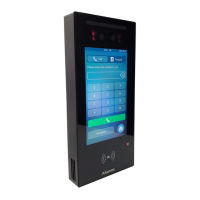
Do you have a question about the Akuvox E16 Series and is the answer not in the manual?
| Touchscreen Type | Capacitive |
|---|---|
| Ingress Protection | IP65 |
| Processor | Quad-Core |
| Communication Protocol | SIP |
| Ethernet | 10/100 Mbps |
| Power Supply | 12V DC or PoE (IEEE 802.3af) |
| Storage | 8GB |
| Display Type | TFT LCD |
| Mounting Type | Wall Mount |
Learn to access and configure device settings directly on the door phone interface.
Access and configure device settings through the web browser interface.
Configure the language display for the device's web interface.
Set up the device's time and date manually or via NTP server.
Configure LED lighting behavior for card reader and white light functions.
Customize screen displays, including screensaver settings for enhanced user experience.
Adjust audio volumes for mic, speaker, and tamper alarms, plus upload custom tones.
Configure DHCP or static IP settings for device network connectivity.
Set up network parameters for device operation, address, and extension.
Configure Network Address Translation (NAT) for optimized communication between devices.
Set up and manage direct IP calls on the intercom device.
Configure SIP accounts, servers, and transport types for call functionality.
Define automatic answering for incoming SIP/IP calls and select modes.
Configure call duration, dial duration, and audio/video codec settings.
Configure relay trigger/hold delays and DTMF modes for door access control.
Control door access via network-based web relays and actions through the interface.
Create, edit, import, and export door access schedules for users or groups.
Set up public and private PIN codes for user door access.
Configure RF card settings, including code format, for door access.
Import user-specific door access configurations from files for batch setup.
Search and edit individual user access permissions and data via the interface.
Configure the tamper alarm function to protect the device from unauthorized removal.
Set up motion detection for enhanced security monitoring and alerts.
Configure email, FTP, and TFTP notifications for security events.
Configure automatic log-out timing for the web interface to enhance security.
Capture MJPEG format monitoring images from the door phone camera.
View real-time video streams from the door phone via web interface or direct URL.
Configure and monitor RTSP streams for audio/video from the door phone.
Configure ONVIF function to enable third-party devices to view video streams.
Check, search, and export call history including dial-out, received, and missed calls.
Access and check door access history, including successful and failed attempts.
View and manage temperature logs, filtering by status and time.
Export system logs for debugging purposes, setting appropriate log levels.
Capture and export PCAP data packets for detailed debugging and troubleshooting.
Understand the principles of auto-provisioning for efficient device setup.
Learn about general and MAC-based configuration file formats for auto-provisioning.
Set up schedules for automatic provisioning of devices at specific times.
Configure DHCP options for automatic device provisioning.
Manually set up server URLs for static auto-provisioning of devices.
Configure Wiegand interface for seamless integration with third-party systems.
Configure RS485 interface for integration with third-party devices.
Configure OSDP settings for authentication with third-party devices.
Restart the device manually or schedule automatic restarts for system refresh.
Reset the device system to its factory default settings for troubleshooting.